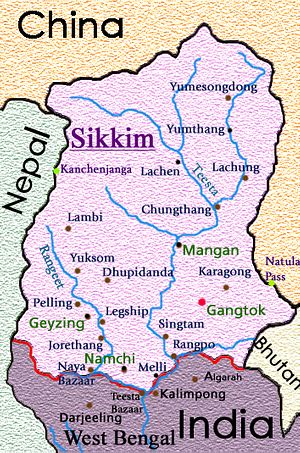A Russia-sponsored referendum vote in the autonomous Ukrainian province of Crimea on March 16 resulted in a strong preference for secession and assimilation into the Russian Federation. Although the results of the referendum are suspect, 96 percent of Crimean ballots were in favor of joining the Russian Federation. The legitimacy of the referendum is under attack by the United States, Europe, and the incumbent government in Ukraine. Although Russia refrained from a unilateral military annexation, the conditions under which the referendum took place essentially amounted to a Russian occupation. Against the backdrop of this state of affairs in Crimea, it’s worth examining one of the last non-reversed annexations and an often forgotten case in the modern history of South Asia: India’s annexation of Sikkim.
While the geopolitical dynamics are obviously vastly different, there are a few similarities to be found in India’s annexation of Sikkim and Russia’s impending annexation of Crimea. Sikkim is today a constituent state of sovereign India, but joined the Indian union in 1975 following a series of events remarkably similar to what has just transpired in Crimea. Traditionally a semi-autonomous Tibetan kingdom, Sikkim fell under the purview of the British Empire in the 18th century. Following its independence in 1947, Sikkim operated as a small, independent Himalayan monarchy (known as the Chogyal monarchy as per its Tibetan heritage) until its assimilation into India in 1975. Sikkim’s relations with India following the independence of both of those states from the British Empire in 1947 were close. India’s first Prime Minister Jawaharlal Nehru demonstrated great interest in maintaining close ties with Sikkim following independence. In fact, the notion of assimilating Sikkim into India was on the mind of India’s leaders immediately after independence. Both Nehru and Sardar Vallabhbhai Patel acknowledged the value of including Sikkim as a special protectorate within the Indian union and worked with Chogyal Tashi Namgyal of Sikkim to attain that status. According to the Indian government’s history of Sikkim, “this was in face of stiff resistance from local parties like Sikkim State Congress who wanted a democratic setup and accession of Sikkim to the Union of India.” As a protectorate, India controlled Sikkim’s external affairs, defense, and communications — a marked difference from the Crimean case today.
The Sikkim State Congress Party would later play a major role in deposing Chogyal Tashi Namgyal’s son, Palden Thondup Namgyal. Tashi Namgyal died in 1963 and following his death the anti-monarchy movement within Sikkim gained traction. In 1955, with Indian assistance, Sikkim established a state council, allowing for constitutional democracy under the Chogyal, who remained Head of State and monarch of the kingdom. Ultimately, in 1973, pro-India protests broke out in Sikkim and the state council requested formal Indian intervention. In 1975, Sikkim’s Prime Minister requested that the state be fully assimilated into India as a state, following which the Indian Army moved into Gangtok (the Sikkimese capital), disarmed the Chogyal’s palace guards, and established control of the state. Following India’s move into Sikkim, a plebiscite among the 59 percent of Sikkimese residents entitled to vote resulted in 97.5 percent of them voting to join India (a result that some Sikkimese argue was a product of Indian duress and manipulation).
India’s annexation of Sikkim involved a plebiscite, similar to the one in Crimea on Sunday. Unlike the Crimean case, India did not intervene in Sikkim on the basis of protecting any particular ethno-linguistic group and did so on the request of an arguably representative body. More significantly, with the exception of the Israeli annexation of the Golan Heights, India’s annexation of Sikkim remains one of the few annexations that stuck and was not reversed in recent history (one can include China and Tibet in the 1950s in this count as well). Similar to the West’s protests over Crimea today, China immediately protested India’s annexation of Sikkim and brought it to the attention of the international community (which ultimately did nothing). In 2003, China acknowledged Sikkim as part of India in exchange for an Indian acknowledgment that Tibet was part of China. Today, the India-China border at Sikkim is the only open border between the two neighbors. Should Crimea accede to the Russian Federation, we will have another case of annexation that will likely go without reversal.

































